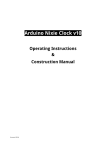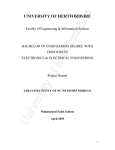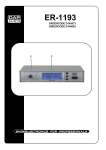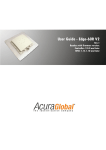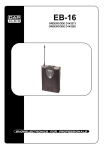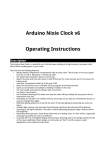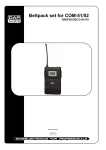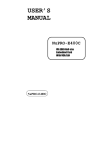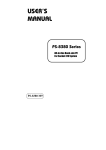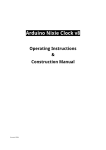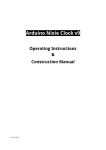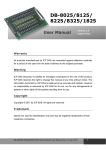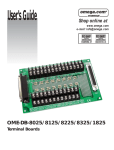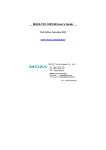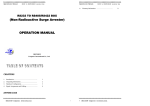Download EMM-OPTO-XT User Manual - Diamond Systems Corporation
Transcript
EMERALD-MM-OPTO PC/104 Module with 2 or 4 Opto-Isolated RS-232/422/485 Ports + 24 Lines of Digital I/O User Manual V1.02 Document no. 765320 Rev A © Copyright 2004 DIAMOND SYSTEMS CORPORATION 8430 Central Ave. Newark, CA 94560 Tel (510) 456-7800 Fax (510) 456-7878 [email protected] http://www.diamondsystems.com/ TABLE OF CONTENTS 1. DESCRIPTION .....................................................................................................................................3 2. FEATURES............................................................................................................................................3 3. SERIAL PORT ISOLATION...............................................................................................................3 4. MECHANICAL DRAWING................................................................................................................4 5. I/O HEADER PINOUTS.......................................................................................................................5 6. BOARD CONFIGURATION...............................................................................................................7 7. DIGITAL I/O .......................................................................................................................................12 8. SPECIFICATIONS .............................................................................................................................14 © 2004 Diamond Systems Corp. Emerald-MM-Opto User Manual V1.0 Page 2 EMERALD-MM-OPTO PC/104 Module with 2 or 4 Opto-Isolated RS-232/422/485 Ports + 24 lines of Digital I/O Models: EMM-OPT2-XT EMM-OPT4-XT 2 serial ports + 24 digital I/O 4 serial ports + 24 digital I/O 1. DESCRIPTION Emerald-MM-OPTO is a PC/104 format I/O module with 2 or 4 optoisolated serial ports, 24 lines of digital I/O, and extended temperature operation. Each serial port can be individually configured for RS-232, RS-422 or RS-485. The digital I/O is provided by a standard 82C55 chip with 3 8-bit ports and programmable direction. It is supported by Diamond Systems’ Universal Driver software for DOS, Linux, QNX, and Windows. Eight different I/O address combinations can be selected, and 9 different interrupt levels can be assigned to configure each port, allowing operation as COM1 through COM4 as well as many other settings. Four I/O headers are provided, one serial port on each header. The board operates on +5V only, eliminating the need for a +12V supply that is often required for serial port operation. The serial ports are based on the Exar ST16C2850 dual UART IC. This device contains 2 identical sets of registers, one for each port, and is compatible with the standard PC serial port and most popular operating systems. It offers an expanded 128-byte FIFO for RX and TX to support higher baud rates as well as an auto-flow feature to control the transmitter during RS-485 half-duplex communications. 2. FEATURES ♦ ♦ ♦ ♦ ♦ ♦ ♦ ♦ ♦ ♦ 2 or 4 serial ports based on 16C2850 UART (1 or 2 UART chips) Galvanic isolation port-to-port and port-to-board, up to 1000V AC or DC RS-232, RS-422, and RS-485 protocols Protocols individually selected with jumpers for each port Termination resistors individually selected with jumpers for each port Jumper-selected I/O address and IRQ settings 24 digital I/O lines using 82C55 +5V only power supply PC/104 format for rugged, compact design Operating temperature -40 to +85oC 3. SERIAL PORT ISOLATION The four serial ports are galvanically isolated from each other and from the rest of the board. The isolation barrier is maintained via HCPL0630 optocouplers for the signals and a DCR010505U isolating DC/DC converter IC. One DC/DC converter chip is used for each serial port circuit. Each DC/DC converter is bypassed with a 10uF capacitor on both the input and output sides. The ground and power planes for each serial port circuit’s section on the board are separated from the main board ground and power planes with an isolation barrier of minimum 0.060”. No traces from any isolated section exceed the boundary of that section’s area. No traces from the non-isolated circuit cross into any isolated section. In special configurations, the four isolated grounds can be connected to the main ground via a 3MΩ resistor chain and/or a 220pF high-voltage capactor. These components will withstand and maintain up to 1KV isolation. Contact Diamond Systems regarding these customizations. © 2004 Diamond Systems Corp. Emerald-MM-Opto User Manual V1.0 Page 3 4. MECHANICAL DRAWING Description of Key Elements J1 J2 J3 J4 J5 J6 J7 J8 PC/104 bus 8-bit bus header PC/104 bus 16-bit bus header Digital I/O Serial port 1 Serial port 2 Serial port 3 Serial port 4 Address selection, baud rate selection, RTS flow control J9 J10 J11 J12 J13 J14 J15 J16 Serial port 4 IRQ selection Serial port 3 IRQ selection Serial port 2 IRQ selection Serial port 1 IRQ selection Serial port 1 configuration & termination Serial port 2 configuration & termination Serial port 3 configuration & termination Serial port 4 configuration & termination Jumper positions shown above are default settings. See chapter 6 for complete details on jumper configuration. © 2004 Diamond Systems Corp. Emerald-MM-Opto User Manual V1.0 Page 4 5. I/O HEADER PINOUTS 5.1 Serial Port Connectors J4, J5, J6, J7 Each serial port has its own 10-pin (2x5) header with the following pinouts. Diamond Systems’ cable no. C-DB9M-1 may be used for each port (qty 2 or 4 per board) to provide a standard male DB9 connector. In RS-232 mode, the pinout conforms to the PC standard for a 9-pin DTE (Data Terminal Equipment) serial port. (NC = No Connection) RS-232 Configuration: NC RXD TXD NC ISO GND 1 3 5 7 9 2 4 6 8 10 NC RTS CTS NC NC RXD+ RXDTXD+ TXDISO GND 1 3 5 7 9 2 4 6 8 10 CTSRTS+ CTS+ RTSNC TXD+/RXD+ TXD-/RXDTXD+/RXD+ TXD-/RXDISO GND 1 3 5 7 9 2 4 6 8 10 NC NC NC NC NC RS-422 Configuration: RS-485 Configuration: In RS-485 mode, only one pair of signal wires is used, plus ground reference. Either pins 1 and 3 or pins 5 and 7 may be used. These signal pairs are duplicated on the connector due to the jumpering of the RX and TX lines on the configuration jumper block. © 2004 Diamond Systems Corp. Emerald-MM-Opto User Manual V1.0 Page 5 Signal Definitions: Signal Name RS-232: RXD RTS TXD CTS Definition Direction Receive Data Request To Send Transmit Data Clear To Send Input Output Output Input RS-422: TXD+, TXDRXD+, RXD- Differential Transmit Data Differential Receive Data Output Input RS-485: TXD/RXD+ TXD/RXD- Differential Transmit/Receive + Differential Transmit/Receive - Bi-directional Bi-directional Common to all protocols: GND Ground NC Not Connected --- 5.2 Digital I/O – J3 The digital I/O is provided on a 26-pin (2x13) pin header with the following pinout. This connector may be used with Diamond Systems’ cable no. C-26-18, which provides a 26-pin female connector at each end. C7 C5 C3 C1 B7 B5 B3 B1 A7 A5 A3 A1 +5V © 2004 Diamond Systems Corp. 1 3 5 7 9 11 13 15 17 19 21 23 25 2 4 6 8 10 12 14 16 18 20 22 24 26 C6 C4 C2 C0 B6 B4 B2 B0 A6 A4 A2 A0 GND Emerald-MM-Opto User Manual V1.0 Page 6 6. BOARD CONFIGURATION Several features are jumper-configurable. All configuration jumpers are dual-row 2mm size. Provision is made on the board for zero-ohm resistors to replace jumpers to enable a hard-wired configuration. ♦ Serial ports 1- 4: address combination (8 address combinations made possible with 3 jumpers providing a 3-bit binary selection) ♦ Serial port IRQ levels ♦ Serial port protocols ♦ RS-422/RS-485 termination resistors ♦ Digital I/O base address (4 address options with 2 jumpers) ♦ Baud rate x4/x1 selection ♦ RTS flow control in RS-485 mode 6.1 Baud rate clock selector – J8 On the I/O address jumper block, position CK is used to select between 1X and 4X baud rate. When the jumper is out, the 7.3728MHz on-board oscillator is divided by 4 to provide a standard 1.8432MHz clock to the UARTs, with a maximum baud rate of 115.2kbps in all protocols. When the jumper is in, the 7.3728MHz is passed directly to the UARTs to enable up to 460.8kbps. To be baud compatible with third party serial ports, you must leave the CK jumper out. Note that in RS-232 mode, the fastest baud rate supported by the SP334 transceiver is 230.4kbps. In RS-422/485 mode the transceiver will operate up to 460.8kbps. 6.2 RTS flow control – J8 Each UART (2 ports) may be configured so that RTS signal control the TXD transmitter. This features is controlled with the HDCNTL- pin on the UART. This feature may be used in RS-485 mode to automatically control the transmitter without requiring software. When data is ready to transmit, RTS goes low, and when transmission is complete RTS goes high again. To use this function, both ports must be configured the same way since only one input is provided for both ports. RTS flow control is configured with the address configuration jumper block. To enable RTS flow control for ports 1 and 2, insert a jumper in the 12 position. To enable RTS flow control for ports 3 and 4, insert a jumper in the 34 position. © 2004 Diamond Systems Corp. Emerald-MM-Opto User Manual V1.0 Page 7 6.3 Serial Port and Interrupt Register Address Selection – J8 The serial ports utilize 5 I/O address blocks in the PC’s I/O memory space: 1. 2. 3. 4. 5. Serial port 1 (8 bytes) Serial port 2 (8 bytes) Serial port 3 (8 bytes) Serial port 4 (8 bytes) Serial port interrupt status register (1 byte) The I/O addresses and baud rate clock selector are combined onto a single jumper block. The I/O addresses are set with jumper block J8, or with 0-ohm resistors located at the bottom center of the board. Eight different I/O address combinations are selectable for the serial ports. The address shown below for each port is the base address (in hex) of that port, i.e. the lowest address of the port’s I/O address block. A B C Port 1 Port 2 Port 3 Port 4 Interrupt Status In In In 3F8 2F8 3E8 2E8 220 Out In In 3E8 2E8 3A8 2A8 220 In Out In 380 388 288 230 224 Out Out In 240 248 260 268 224 In In Out 100 108 110 118 240 Out In Out 120 128 130 138 244 In Out Out 140 148 150 158 248 Out Out Out 160 168 170 178 24C 6.4 Digital I/O Addresses – J8 The 82C55 IC occupies 4 bytes of I/O space, selected by the D and E jumpers of J8 or by using the corresponding 0-ohm resistors. All addresses are in hex. D E Address In In 200-203 Out In 240-243 In Out 280-283 Out Out 300-303 © 2004 Diamond Systems Corp. Emerald-MM-Opto User Manual V1.0 Page 8 6.5 Serial protocol selection and configuration – J13, J14, J15 and J16 The serial ports are configured with 4 jumper blocks, one for each port. The jumper blocks have the following functions: Position Name Function 1 232 In = RS-232, out = RS-422/RS-485 2 RTS Ctrl In = RTS controls TX transceiver in RS-485 mode Out = TX transceiver is always enabled 3 Echo In = TX enable causes RX disable to prevent echo during transmission Out = RX is always enabled 4 TXD Term In enables TXD termination 5 RXD+ Term In enables RXD high side termination / bias 6 RXD- Term In enables RXD low side terminatoin / bias 7 RTS Term In enables RTS termination 8 CTS+ Term In enables CTS high side termination / bias 9 CTS- Term In enables CTS low side terminatoin / bias 10 TX/RX+ Connect TX+ and RX+ for half-duplex 2-wire operation 11 TX/RX- Connect TX- and RX- for half-duplex 2-wire operation RS-232 Operation Position 1 is in, and all other positions are out. RX and TX are used. RTS and CTS may optionally be used. RS-422 Operation Positions 1, 2, 3, 10, and 11 are out. Positions 4-9 may be used as needed for termination / bias functions. In RS-422 mode, both RXD and TXD twisted pairs are used, and RTS/CTS pairs may optionally be used. RS-485 Operation Position 1 is out, and positions 2, 10 and 11 are in. If auto-485 mode (UART controls RTS line automatically in hardware) is desired, set the appropriate jumper (12 or 34) on J8. If local echo is not desired, install a jumper in position 3. In RS-485 mode, only one pair RX/TX+ and RX/TX- are used, plus signal reference. In this mode, jumpers 2 and 3 may be used for RTS flow control and echo prevention during transmission. Positions 5 and 8 enable a 1K pull-up failsafe resistor on the RXD+ and CTS+ lines respectively. Positions 6 and 9 enable a 1K pull-down failsafe resistor on the RXD- and CTS- lines respectively. RS-422 / RS-485 Cable Endpoint Termination In RS-422 or RS-485 networks, termination resistors are normally installed at the endpoints of the cables to minimize reflections on the lines. Emerald-MM-OPT4-XT provides 150Ω resistors for this purpose. To enable resistor termination, install jumpers in the locations 4-9 of J13, J14, J15, or J16 (for ports 1 – 4, respectively). Termination is only needed, and should only be used, at the cable endpoints. Installing termination resistors at additional points in the network may cause overloading and failure of the line drivers due to the lower impedance caused by multiple resistors in parallel. © 2004 Diamond Systems Corp. Emerald-MM-Opto User Manual V1.0 Page 9 6.6 Interrupt Levels – J9, J10, J11, J12 Each serial port has its own IRQ level selection jumper block: ♦ ♦ ♦ ♦ COM1 IRQ = J12 COM2 IRQ = J11 COM3 IRQ = J10 COM4 IRQ = J9 Ports may have independent IRQs or they may share IRQs in any combination, depending on the configuration. The available IRQ levels for each port are 2, 3, 4, 5, 6, 7, 10, 12, and 15. Interrupt Pulldown Resistor In order to guarantee valid logic levels on the line when the device is not requesting service, each active interrupt level requires a 1KΩ pulldown resistor. Only one such resistor should be used on each active interrupt line. Each interrupt configuration header on Emerald-MM-OPT4-XT has a position marked “R” for enabling the pulldown resistor. Install a jumper in this position to connect the resistor, and remove the jumper to disconnect the resistor. If two or more ports are sharing the same interrupt level, install the jumper in the R position for any one of the ports and leave it off the others. Interrupt Sharing On the PC/104 bus, interrupt levels may be shared by multiple devices. For this reason, the interrupt is driven to a logic high level by the device requesting service, and when the device is serviced it tristates the line rather than driving it low. This technique avoids contention by two devices trying to drive the line with opposing logic levels. Interrupt Status Register The interrupt status register (see section 7.3 for I/O location) indicates the status of each port’s interrupt request line. It operates regardless of whether interrupt sharing is enabled (see above). If two or more ports are sharing the same interrupt level, the status register will still indicate the correct status of each port’s interrupt request line. Bit No. 7 6 5 4 3 2 1 0 Name X X X X INT4 INT3 INT2 INT1 Definitions: X Bit not used; reads back as a 0 INT4-1 Status of interrupt request for each port: 0 = no interrupt request active for this port 1 = interrupt request active for this port © 2004 Diamond Systems Corp. Emerald-MM-Opto User Manual V1.0 Page 10 6.7 Default Settings The default settings for Emerald-MM-Opto are as follows: Protocol settings: All ports set for RS-232 Address/Interrupt settings: (J7 A B C = In In Out): Feature Port 1 Port 2 Port 3 Port 4 Interrupt Status Address 100 108 100 108 240 © 2004 Diamond Systems Corp. Interrupt level 3 3 3 3 Emerald-MM-Opto User Manual V1.0 Page 11 7. DIGITAL I/O 24 TTL digital I/O lines are provided by a 82C55 chip. Each line can source 2.5mA in a logic 0 state and sink 2.5mA in a logic 1 state. I/O lines are unbuffered, i.e. there is a direct connection between the 82C55 and the I/O header. All digital I/O lines are pulled up to +5V with 10KΩ pull-up resistors. 7.1 Digital I/O Register Map The digital I/O provided by the 82C55 chip occupies 4 bytes of I/O space. The base address for this I/O space is configured using J8 (see section 7.4). Base + Function 0 DIO port A 1 DIO port B 2 DIO port C 3 DIO configuration register 7.2 Digital I/O Register Definitions Base + 0: Digital I/O Register A, 82C55 no. 1 Bit Name A7-A0 7 6 5 4 3 2 1 0 A7 A6 A5 A4 A3 A2 A1 A0 Digital I/O port A Base + 1: Digital I/O Register B, 82C55 no. 1 Bit Name B7-B0 7 6 5 4 3 2 1 0 B7 B6 B5 B4 B3 B2 B1 B0 Digital I/O port B Base + 2: Digital I/O Register C, 82C55 no. 1 Bit Name C7-C0 7 6 5 4 3 2 1 0 C7 C6 C5 C4 C3 C2 C1 C0 Digital I/O port C © 2004 Diamond Systems Corp. Emerald-MM-Opto User Manual V1.0 Page 12 Base + 3: Digital I/O Configuration Register This control register determines the direction and mode of the 82C55 digital I/O lines. Most applications use the simple I/O configuration, in which bit 7 is set to 1 and the Mode is set to 0 for all ports. Only the port direction bits need to be set. For more complex operations with handshaking, concult the 82C55 datasheet attached at the end of this manual. Here is a list of common configuration register control bytes: Configuration Byte Hex 9B Decimal 155 Port A Input Port B Input Port C (both halves) Input 92 146 Input Input Output 99 153 Input Output Input 90 144 Input Output Output 8B 139 Output Input Input 82 130 Output Input Output 89 137 Output Output Input 80 128 Output Output Output © 2004 Diamond Systems Corp. Emerald-MM-Opto User Manual V1.0 Page 13 8. SPECIFICATIONS Serial Ports No. of serial ports: Protocol: Maximum baud rate: Communications parameters: Short circuit protection: Isolation Voltage: 4 RS-232, RS-422, RS-485; Jumper selected 460.8kbps 5, 6, 7, or 8 data bits; Even, odd, or no parity All outputs protected against continuous short circuit 1000VDC or AC Isolation coupling option: 3MΩ in parallel with 220pF (consult factory for more details) RS-232 mode: Input impedance: 3KΩ min Input voltage swing: ±30V max Output voltage swing: ±5V min, ±7V typical RS-422, RS-485 modes: Differential input threshold: -0.2V min, +0.2V max Input impedance: Input current: 12KΩ min +1.0mA max (VIN = 12V) -0.8mA max (VIN = -7V) Differential output voltage: High/low states differential output voltage symmetry: 2.0V min (RL = 50Ω) 0.2V max Digital I/O No. of I/O lines: Direction: Input voltage: Output voltage: 24 Programmable: Ports A and B individually programmable for all input or all output. Port C programmable in 4-bit groups for input or output. Low -0.5V min, 0.8V max High 2.0V min, 5.5V max Low 0.0V min, 0.4V max High 3.0V min, Vcc - 0.4V max Output current: ±2.5mA max, each line Pull-up resistors: 10KΩ to +5VDC, all lines General I/O headers: Mating cables: Dimensions: Power supply: Current consumption: Operating temperature: Operating humidity: PC/104 bus: © 2004 Diamond Systems Corp. Serial ports: 2 or 4 10-position (2x5) .025” square pin header on .1” centers Digital I/O: 26-pin (2x13) .025” square pin header on .1” centers Serial ports: Diamond Systems no. C-DB9M-1 (one per port) Digital I/O: Diamond Systems no. C-26-18 3.55” x 3.775” (PC/104 standard) +5VDC ±10% 80mA typical, all outputs unloaded -40 to +85oC 5% to 95% noncondensing 8 bit and 16-bit bus headers are installed and used (16-bit header is used for interrupt levels only) Emerald-MM-Opto User Manual V1.0 Page 14
















